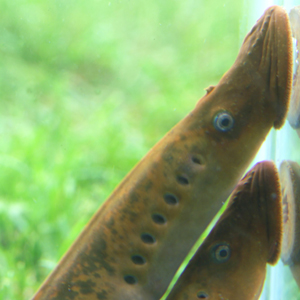The invasive species people worry about most are those accidentally introduced and that significantly alter the local ecology. In the Great Lakes, the most famous invasive species is the rather gruesome Sea Lamprey.

Having entered the Great Lakes through the Welland Canal in 1829, the saltwater Sea Lamprey has wreaked terrible havoc on native species. They often eat as much as 20 pounds of fish flesh during their life cycle, and can kill even the largest Lake Trout, the top predator in Lake Superior. Here is a picture of the gruesome effects of lamprey on lakers:

There are many other invasive species in the Great Lakes. These include the Rusty Crawfish, the Spiny Water Flea, the Zebra Mussel, and most recently, the Goby and Ruffe, two voracious little fish from the Caspian Sea that came to the Great Lakes in the ballast of saltwater tankers.
The Rainbow Smelt is another invasive species, only this one was introduced into Lake Michigan in the early twentieth century as a forage fish for stocked salmon, yet another invasive species introduced into these waters. By 1930, they had migrated from Lake Michigan to Lake Superior, where they thrived. Huge schools of smelt would run the rivers to spawn, and were at first seen as a huge nuisance. In the post-World War II era, however, they began to be harvested commercially as well as for sport, and the smelt run became an annual tradition along Lake Superior's northwest coast line.

The smelt numbers began to dramatically decline in the 1980s, and continue to dip down to the present. Although the smelt still run in the Lester, Knife, French and other rivers, their numbers are tiny compared to the heyday of the smelt run. But no matter how you look at it, the Rainbow Smelt is an invasive species that took a terriible toll on the native feed fish such as the cisco and tullibee, whose numbers suffered tremendously with the rise of the smelt. Perhaps with the decline in smelt numbers, these native fish will rebound, but with the recent introduction of the ruffe and goby, the odds are not in their favor.
[Update courtesy Bill Sonnett] Not to nit pick the smelt issue, but they were not introduced into Lake Michigan but rather a small inland lake (if my memory is right Crystal Lake) as forage for a stocked population of salmon. In any case they made their way down stream on their own and showed up in Lake Michigan in 1930, 18 years after the original planting in the inland lake. From there they exploded into the Great Lakes. Those who are mourning their demise can take hope from the fact that the smelt population crashed in the early 1950's and despite many who predicted an end to future smelt runs. the smelt came back with a vengence.
--Dr. Todd
No comments:
Post a Comment